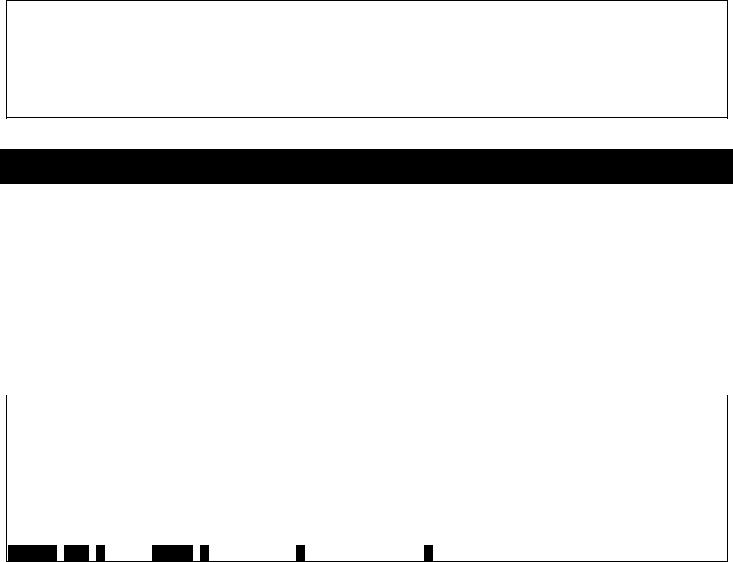D-Link DGS-3600 User Manual

CLI Reference Guide
ProductModel: xStack® DGS-3600 Series
Layer 3 Managed Gigabit Ethernet Switch
Release 2.8
TABLE OF CONTENTS |
|
INTRODUCTION .................................................................................................................................................................... |
1 |
USING THE CONSOLE CLI................................................................................................................................................... |
3 |
COMMAND SYNTAX ............................................................................................................................................................. |
6 |
BASIC SWITCH COMMANDS............................................................................................................................................... |
8 |
BASIC IP COMMANDS........................................................................................................................................................ |
22 |
BPDU TUNNELING COMMANDS....................................................................................................................................... |
28 |
802.1X COMMANDS............................................................................................................................................................ |
31 |
ACCESS AUTHENTICATION CONTROL COMMANDS .................................................................................................... |
52 |
ACCESS CONTROL LIST (ACL) COMMANDS.................................................................................................................. |
73 |
ACL FLOW METERING COMMANDS ................................................................................................................................ |
84 |
ADDRESS RESOLUTION PROTOCOL (ARP) COMMANDS ............................................................................................ |
89 |
ARP SPOOFING PREVENTION COMMANDS ................................................................................................................... |
93 |
BORDER GATEWAY PROTOCOL (BGP) DEBUG COMMANDS ..................................................................................... |
95 |
BORDER GATEWAY PROTOCOL (BGP) COMMANDS ................................................................................................. |
111 |
BPDU ATTACK PROTECTION COMMANDS .................................................................................................................. |
156 |
CABLE DIAGNOSTICS COMMAND LIST ........................................................................................................................ |
160 |
COMMAND HISTORY LIST............................................................................................................................................... |
162 |
COMMAND LOGGING COMMANDS................................................................................................................................ |
165 |
COMPOUND AUTHENTICATION COMMANDS............................................................................................................... |
167 |
CONFIGURATION COMMANDS....................................................................................................................................... |
174 |
COUNTER COMMANDS ................................................................................................................................................... |
179 |
DEBUG COMMANDS ........................................................................................................................................................ |
183 |
DHCP LOCAL RELAY COMMANDS ................................................................................................................................ |
189 |
DHCP RELAY COMMANDS.............................................................................................................................................. |
191 |
DHCP SERVER SCREENING COMMANDS..................................................................................................................... |
201 |
DHCP SERVER COMMANDS ........................................................................................................................................... |
205 |
DHCPV6 CLIENT COMMANDS......................................................................................................................................... |
220 |
DHCPV6 RELAY COMMANDS ......................................................................................................................................... |
223 |
DHCPV6 SERVER COMMANDS....................................................................................................................................... |
229 |
D-LINK SINGLE IP MANAGEMENT COMMANDS........................................................................................................... |
241 |
D-LINK UNIDIRECTIONAL LINK DETECTION (DULD) COMMANDS ............................................................................ |
252 |
DOMAIN NAME SERVER (DNS)RELAY COMMANDS.................................................................................................... |
254 |
DOMAIN NAME SYSTEM (DNS) RESOLVER COMMANDS ........................................................................................... |
258 |
DVMRP COMMANDS ........................................................................................................................................................ |
263 |
ETHERNET RING PROTECTION SWITCHING (ERPS) COMMANDS............................................................................ |
268 |
FILTER DATABASE (FDB) COMMANDS......................................................................................................................... |
278 |
FLASH FILE SYSTEM (FFS) COMMANDS ...................................................................................................................... |
285 |
GRATUITOUS ARP COMMANDS..................................................................................................................................... |
291 |
IEEE 802.1Q VLAN COMMANDS ..................................................................................................................................... |
295 |
IEEE 802.1QINQ COMMANDS.......................................................................................................................................... |
305 |
IGMP AND MLD SNOOPING COMMANDS...................................................................................................................... |
310 |
INTERNET GROUP MANAGEMENT PROTOCOL (IGMP) COMMANDS ....................................................................... |
329 |
IP DIRECTED BROADCAST COMMANDS ...................................................................................................................... |
334 |
IP MULTICASTING COMMANDS...................................................................................................................................... |
336 |
IP ROUTE FILTER COMMANDS....................................................................................................................................... |
338 |
IP-MAC-PORT BINDING (IMPB) COMMANDS ................................................................................................................ |
349 |
IPV6 NEIGHBOR DISCOVER COMMANDS ..................................................................................................................... |
365 |
IPV6 ROUTE COMMANDS................................................................................................................................................ |
371 |
IPV6 TUNNEL COMMANDS.............................................................................................................................................. |
374 |
JAPANESE WEB-BASED ACCESS CONTROL (JWAC) COMMANDS ......................................................................... |
380 |
JUMBO FRAME COMMANDS .......................................................................................................................................... |
398 |
LIMITED IP MULTICAST ADDRESS COMMANDS.......................................................................................................... |
400 |
LINK AGGREGATION COMMANDS................................................................................................................................. |
407 |
LINK LAYER DISCOVERY PROTOCOL (LLDP) COMMANDS....................................................................................... |
412 |
LOOPBACK INTERFACE COMMANDS........................................................................................................................... |
428 |
LOOPBACK INTERFACE COMMANDS........................................................................................................................... |
432 |
MAC NOTIFICATION COMMANDS .................................................................................................................................. |
435 |
MAC-BASED ACCESS CONTROL COMMANDS ............................................................................................................ |
439 |
MESSAGE-DIGEST ALGORITHM 5 (MD5) COMMANDS ............................................................................................... |
452 |
MIRROR COMMANDS....................................................................................................................................................... |
455 |
MSTP DEBUG ENHANCEMENT COMMANDS ................................................................................................................ |
460 |
IGMP SNOOPING MULTICAST (ISM) VLAN COMMANDS............................................................................................. |
467 |
MULTIPLE SPANNING TREE PROTOCOL (MSTP) COMMANDS ................................................................................. |
472 |
NETWORK LOAD BALANCING (NLB) COMMANDS...................................................................................................... |
483 |
OPEN SHORTEST PATH FIRST (OSPFV3) COMMANDS .............................................................................................. |
486 |
OSPF COMMANDS ........................................................................................................................................................... |
500 |
OSPF DEBUG ENHANCEMENT COMMANDS ................................................................................................................ |
517 |
PASSWORD ENCRYPTION COMMANDS ....................................................................................................................... |
534 |
PING COMMANDS ............................................................................................................................................................ |
538 |
POLICY ROUTE COMMANDS .......................................................................................................................................... |
542 |
PORT SECURITY COMMANDS........................................................................................................................................ |
545 |
PROTOCOL INDEPENDENT MULTICAST (PIM) COMMANDS ...................................................................................... |
548 |
PROTOCOL VLAN GROUP COMMANDS........................................................................................................................ |
564 |
QUALITY OF SERVICE (QOS) COMMANDS ................................................................................................................... |
569 |
REMOTE COPY PROTOCOL (RCP) COMMANDS.......................................................................................................... |
582 |
REMOTE SWITCHED PORT ANALYZER (RSPAN) COMMANDS.................................................................................. |
593 |
RIPNG COMMANDS.......................................................................................................................................................... |
599 |
ROUTING INFORMATION PROTOCOL (RIP) COMMANDS ........................................................................................... |
604 |
SAFEGUARD ENGINE COMMANDS ............................................................................................................................... |
607 |
SECURE SHELL (SSH) COMMANDS .............................................................................................................................. |
610 |
SECURE SOCKETS LAYER (SSL) COMMANDS............................................................................................................ |
616 |
SFLOW COMMANDS ........................................................................................................................................................ |
621 |
SIMPLE NETWORK MANAGEMENT PROTOCOL (SNMP) COMMANDS ..................................................................... |
630 |
STACKING COMMANDS .................................................................................................................................................. |
643 |
STATIC MAC-BASED VLAN COMMANDS ...................................................................................................................... |
648 |
STATIC MULTICAST ROUTE COMMANDS..................................................................................................................... |
650 |
SUBNET VLAN COMMANDS............................................................................................................................................ |
652 |
SUPER VLAN COMMANDS.............................................................................................................................................. |
656 |
SWITCH PORT COMMANDS............................................................................................................................................ |
660 |
SYSLOG OR TRAP SOURCE-INTERFACE COMMANDS .............................................................................................. |
666 |
SYSTEM LOG COMMANDS.............................................................................................................................................. |
669 |
TECHNICAL SUPPORT COMMANDS.............................................................................................................................. |
680 |
TELNET CLIENT COMMANDS ......................................................................................................................................... |
683 |
TFTP CLIENT COMMANDS .............................................................................................................................................. |
684 |
TIME AND SNTP COMMANDS ......................................................................................................................................... |
689 |
TIME RANGE COMMANDS............................................................................................................................................... |
695 |
TRACE ROUTE COMMANDS ........................................................................................................................................... |
697 |
TRAFFIC CONTROL COMMANDS................................................................................................................................... |
700 |
TRAFFIC SEGMENTATION COMMANDS........................................................................................................................ |
704 |
TRUSTED HOST COMMANDS ......................................................................................................................................... |
706 |
UNICAST ROUTE COMMANDS........................................................................................................................................ |
708 |
UTILIZATION COMMANDS............................................................................................................................................... |
722 |
VLAN TRUNKING COMMANDS ....................................................................................................................................... |
725 |
VRRP DEBUG COMMANDS ............................................................................................................................................. |
728 |
VRRP COMMANDS ........................................................................................................................................................... |
734 |
WEB-BASED ACCESS CONTROL (WAC) COMMANDS................................................................................................ |
740 |
PASSWORD RECOVERY COMMANDS........................................................................................................................... |
750 |
TECHNICAL SPECIFICATIONS........................................................................................................................................ |
751 |

xStack® DGS-3600 Series Layer 3 Gigabit Ethernet Managed Switch CLI Manual
1
INTRODUCTION
The Switch can be managed through the Switch’s serial port, Telnet, or the Web-based management agent. The Command Line Interface (CLI) can be used to configure and manage the Switch via the serial port or Telnet interfaces.
The DGS-3600 Layer 3 stackable Gigabit Ethernet switch series are members of the D-Link xStack® family. Ranging from 10/100Mbps edge switches to core gigabit switches, the xStack® switch family has been future-proof designed to provide a stacking architecture with fault tolerance, flexibility, port density, robust security and maximum throughput with a user-friendly management interface for the networking professional.
This manual provides a reference for all of the commands contained in the CLI for the xStack® DGS-3612, DGS-3612G, DGS-3627, DGS-3627G, DGS-3627, DGS-3627G and DGS-3650 series of switches. Configuration and management of the Switch via the Web-based management agent is discussed in the User’s Guide.
NOTE: For the remainder of this manual, all versions of the DGS-3612, DGS-3612G, DGS-3627, DGS3627G, DGS-3627, DGS-3627G and DGS-3650 switches will be referred to as simply the Switch or the DGS-3627.
Accessing the Switch via the Serial Port
The Switch’s serial port’s default settings are as follows:
1.115200 baud
2.no parity
3.8 data bits
4.1 stop bit
A computer running a terminal emulation program capable of emulating a VT-100 terminal and a serial port configured as above is then connected to the Switch’s serial port via an RS-232 DB-9 cable.
With the serial port properly connected to a management computer, the following screen should be visible. If this screen does not appear, try pressing Ctrl+r o refresh the console screen.
DGS-3627 Gigabit Ethernet Switch
Command Line Interface
Firmware: Build 2.80.B31
Copyright(C) 2010 D-Link Corporation. All rights reserved.
UserName:
Figure 1-1. Initial CLI screen
There is no initial username or password. Just press the Enter key twice to display the CLI input cursor −DGS3627:admin# . This is the command line where all commands are input.
Setting the Switch’s IP Address
Each Switch must be assigned its own IP Address, which is used for communication with an SNMP network manager or other TCP/IP application (for example BOOTP, TFTP). The Switch’s default IP address is 10.90.90.90. You can change the default Switch IP address to meet the specification of your networking address scheme.
1

xStack® DGS-3600 Series Layer 3 Gigabit Ethernet Managed Switch CLI Manual
The Switch is also assigned a unique MAC address by the factory. This MAC address cannot be changed, and can be found on the initial boot console screen – shown below.
Boot Procedure |
1.10-B09 |
-----------------------------------------------------------------------------
Power On Self |
Test ...................................... |
100 |
% |
MAC Address |
: 00-19-5B-F5-26-C0 |
|
|
H/W Version |
: 1A1G |
|
|
Please wait, loading V2.80.B31 Runtime image ............ |
100 |
% |
|
UART init ............................................... |
|
100 |
% |
Device Discovery ........................................ |
- |
|
|
Figure 1-2. Boot screen
The Switch’s MAC address can also be found in the Web management program on the Switch Information (Basic Settings) window in the Configuration menu.
The IP address for the Switch must be set before it can be managed with the Web-based manager. The Switch IP address can be automatically set using BOOTP or DHCP protocols, in which case the actual address assigned to the Switch must be known.
The IP address may be set using the Command Line Interface (CLI) over the console serial port as follows:
1.Starting at the command line prompt, enter the commands config ipif System ipaddress xxx.xxx.xxx.xxx/yyy.yyy.yyy.yyy. Where the x’s represent the IP address to be assigned to the IP interface named System and the y’s represent the corresponding subnet mask.
2.Alternatively, you can enter config ipif System ipaddress xxx.xxx.xxx.xxx/z. Where the x’s represent the IP address to be assigned to the IP interface named System and the z represents the corresponding number of subnets in CIDR notation.
The IP interface named System on the Switch can be assigned an IP address and subnet mask which can then be used to connect a management station to the Switch’s Telnet or Web-based management agent.
DGS-3627:admin# config ipif System ipaddress 10.24.22.200/255.0.0.0
Command: config ipif System ipaddress 10.24.22.200/8
Success.
DGS-3627:admin#
Figure 1-3. Assigning an IP Address
In the above example, the Switch was assigned an IP address of 10.24.22.200 with a subnet mask of 255.0.0.0. The system message Success indicates that the command was executed successfully. The Switch can now be configured and managed via Telnet, SNMP MIB browser and the CLI or via the Web-based management agent using the above IP address to connect to the Switch.
2

xStack® DGS-3600 Series Layer 3 Gigabit Ethernet Managed Switch CLI Manual
2
USING THE CONSOLE CLI
The Switch supports a console management interface that allows the user to connect to the Switch’s management agent via a serial port and a terminal or a computer running a terminal emulation program. The console can also be used over the network using the TCP/IP Telnet protocol. The console program can be used to configure the Switch to use SNMPbased network management software over the network.
This chapter describes how to use the console interface to access the Switch, change its settings, and monitor its operation.
NOTE: Switch configuration settings are saved to non-volatile RAM using the save command. The current configuration will then be retained in the Switch’s NV-RAM, and reloaded when the Switch is rebooted. If the Switch is rebooted without using the save command, the last configuration saved to NV-RAM will be loaded.
Connecting to the Switch
The console interface is used by connecting the Switch to a VT100-compatible terminal or a computer running an ordinary terminal emulator program (e.g., the HyperTerminal program included with the Windows operating system) using an RS-232C serial cable. Your terminal parameters will need to be set to:
•VT-100 compatible
•115200 baud
•8 data bits
•No parity
•One stop bit
•No flow control
Users can also access the same functions over a Telnet interface. Once an IP address has been set for the Switch, users can use a Telnet program (in VT-100 compatible terminal mode) to access and control the Switch. All of the screens are identical, whether accessed from the console port or from a Telnet interface.
After the Switch reboots and you have logged in, the console looks like this:
DGS-3627 Gigabit Ethernet Switch
Command Line Interface
Firmware: Build 2.80.B31
Copyright(C) 2010 D-Link Corporation. All rights reserved.
UserName:
PassWord:
DGS-3627:admin# _
Figure 2- 1. Initial Console Screen after logging in
Commands are entered at the command prompt, DGS-3627:admin# .
There are a number of helpful features included in the CLI. Entering the ? command will display a list of all of the toplevel commands.
3

xStack® DGS-3600 Series Layer 3 Gigabit Ethernet Managed Switch CLI Manual
DGS-3627:admin# ?
Command: ?
..
?
cable_diag ports cd
clear
clear address_binding dhcp_snoop binding_entry ports clear address_binding nd_snoop binding_entry ports clear arptable
clear attack_log clear bgp
clear bgp dampening
clear bgp flap_statistics clear counters
clear dhcp_binding clear dhcpv6 binding clear fdb
clear ip prefix_list counter clear jwac auth_state
clear log
clear mac_based_access_control auth_state clear port_security_entry port
clear wac auth_state
CTRL+C ESC q Quit SPACE n Next Page Enter Next Entry a All
Figure 2- 2. The ? Command
When users enter a command without its required parameters, the CLI will prompt a Next possible completions: message.
DGS-3627:admin# config account Command: config account
Next possible completions: <username>
DGS-3627:admin#
Figure 2- 3. Example Command Parameter Help
In this case, the command config account was entered with the parameter <username>. The CLI will then prompt to enter the <username> with the message, Next possible completions:. Every command in the CLI has this feature, and complex commands have several layers of parameter prompting.
In addition, after typing any given command plus one space, all of the next possible sub-commands can be seen, in sequential order, by repeatedly pressing the Tab key.
To re-enter the previous command at the command prompt, press the up arrow cursor key. The previous command will appear at the command prompt.
DGS-3627:admin# config account Command: config account
Next possible completions: <username>
DGS-3627:admin# config account
Figure 2- 4. Using the Up Arrow to Re-enter a Command
4

xStack® DGS-3600 Series Layer 3 Gigabit Ethernet Managed Switch CLI Manual
In the above example, the command config account was entered without the required parameter <username>, the CLI returned the Next possible completions: <username> prompt. The up arrow cursor control key was pressed to reenter the previous command (config account) at the command prompt. Now the appropriate username can be entered and the config account command re-executed.
All commands in the CLI function in this way. In addition, the syntax of the help prompts are the same as presented in this
manual − angle brackets < > indicate a numerical value or character string, braces { } indicate optional parameters or a choice of parameters, and brackets [ ] indicate required parameters.
If a command is entered that is unrecognized by the CLI, the top-level commands will be displayed under the Available commands: prompt.
DGS-3627:admin# the |
|
|
|
Available commands: |
? |
cable_diag |
cd |
.. |
|||
clear |
config |
copy |
create |
debug |
delete |
dir |
disable |
download |
enable |
erase |
login |
logout |
no |
ping |
ping6 |
reboot |
reconfig |
rename |
reset |
save |
show |
telnet |
traceroute |
traceroute6 |
upload |
|
|
DGS-3627:admin# |
|
|
|
|
|
Figure 2- 5. Available Commands |
|
The top-level commands consist of commands such as show or config. Most of these commands require one or more parameters to narrow the top-level command. This is equivalent to show what? or config what? Where the what? is the next parameter.
For example, if you enter the create command with no additional parameters, the CLI will then display all of the possible next parameters.
DGS-3627:admin# create |
|
|
|
Command: create |
|
|
|
Next possible completions: |
account |
address_binding |
|
802.1x |
access_profile |
||
arpentry |
authen |
authen_enable |
authen_login |
authentication |
bgp |
cpu |
dhcp |
dhcpv6 |
dot1v_protocol_group |
host_name |
double_vlan |
erps |
fdb |
igmp_snooping |
|
ip |
ip_tunnel |
ipif |
ipmroute |
iproute |
ipv6 |
ipv6route |
jwac |
link_aggregation |
loopback |
mac_based_access_control |
|
mac_based_access_control_local |
mac_based_vlan |
md5 |
|
mirror |
multicast_fdb |
multicast_range |
nlb |
ospf |
ospfv3 |
pim |
policy_route |
route |
route_map |
rspan |
sflow |
snmp |
stp |
subnet_vlan |
super_vlan |
syslog |
trusted_host |
vlan |
vlan_translation |
vrrp |
wac |
|
|
DGS-3627:admin#
Figure 2- 6. Next possible completions: Create command
In the above example, all of the possible next parameters for the create command are displayed.
5

xStack® DGS-3600 Series Layer 3 Gigabit Ethernet Managed Switch CLI Manual
3
COMMAND SYNTAX
The following symbols are used to describe how command entries are made and values and arguments are specified in this manual. The online help contained in the CLI and available through the console interface uses the same syntax.
NOTE: All commands are case-sensitive. Be sure to disable Caps Lock or any other unwanted function that changes text case.
<angle brackets>
Purpose |
Encloses a variable or value that must be specified. |
|
|
Syntax |
create ipif <ipif_name 12> <network_address> (<ip_addr/netmask>) <vlan_name 32> |
|
{secondary | state [enable | disable]} |
Description |
In the above syntax example, users must supply an IP interface name in the <ipif_name> |
|
space, a VLAN name in the <vlan_name 32> space, and the network address, including the |
|
netmask, in the <network_address> (<ip_addr/netmask>) space. Do not type the angle |
|
brackets. |
|
|
Example Command |
create ipif Engineering 10.24.22.5/255.0.0.0 Design |
|
|
[square brackets]
Purpose |
Encloses a required value or set of required arguments. One value or argument can be |
|
specified. |
|
|
Syntax |
create account [admin | operator | user] <username 15> |
|
|
Description |
In the above syntax example, users must specify the admin, operator, or user level account to |
|
be created. Do not type the square brackets. |
Example Command |
create account admin ctsnow |
|
|
| vertical bar
Purpose |
Separates two or more mutually exclusive items in a list, one of which must be entered. |
|
|
Syntax |
create account [admin | operator |user] <username 15> |
|
|
Description |
In the above syntax example, you must specify the admin, operator, or user level account to |
|
be created. Do not type the backslash. |
Example Command |
create account admin ctsnow |
|
|
{braces}
Purpose |
Encloses an optional value or set of optional arguments. |
|
|
6

|
|
xStack® DGS-3600 Series Layer 3 Gigabit Ethernet Managed Switch CLI Manual |
|
|
|
|
|
|
|
|
{braces} |
|
|
|
|
|
|
|
|
|
Syntax |
|
reset {[config | system]} |
|
|
|
|
|
|
|
Description |
|
In the above syntax example, users have the option to specify config or system. It is not |
|
|
|
|
necessary to specify either optional value, however the effect of the system reset is dependent |
|
|
|
|
on which, if any, value is specified. Therefore, with this example there are three possible |
|
|
|
|
outcomes of performing a system reset. See the following chapter, Basic Commands for more |
|
|
|
|
details about the reset command. |
|
|
|
|
|
|
|
Example command |
|
reset config |
|
|
|
|
|
|
|
|
|
|
|
|
Line Editing Key Usage |
|
||
|
|
|
|
|
|
Delete |
|
Deletes the character under the cursor and then shifts the remaining characters in the line to the |
|
|
|
|
left. |
|
|
|
|
|
|
|
Backspace |
|
Deletes the character to the left of the cursor and then shifts the remaining characters in the line |
|
|
|
|
to the left. |
|
|
|
|
|
|
|
Left Arrow |
|
Moves the cursor to the left. |
|
|
|
|
|
|
|
Right Arrow |
|
Moves the cursor to the right. |
|
|
|
|
|
|
|
Up Arrow |
|
Repeats the previously entered command. Each time the up arrow is pressed, the command |
|
|
|
|
previous to that displayed appears. This way it is possible to review the command history for the |
|
|
|
|
current session. Use the down arrow to progress sequentially forward through the command |
|
|
|
|
history list. |
|
|
|
|
|
|
|
Down Arrow |
|
The down arrow will display the next command in the command history entered in the current |
|
|
|
|
session. This displays each command sequentially as it was entered. Use the up arrow to |
|
|
|
|
review previous commands. |
|
|
|
|
|
|
|
Tab |
|
Shifts the cursor to the next field to the left. |
|
|
|
|
|
|
|
|
|
|
|
|
Multiple Page Display Control Keys |
|
||
|
|
|
|
|
|
Space |
|
Displays the next page. |
|
|
|
|
|
|
|
CTRL+c |
|
Stops the display of remaining pages when multiple pages are to be displayed. |
|
|
|
|
|
|
|
ESC |
|
Stops the display of remaining pages when multiple pages are to be displayed. |
|
|
|
|
|
|
|
n |
|
Displays the next page. |
|
|
|
|
|
|
|
p |
|
Displays the previous page. |
|
|
|
|
|
|
|
q |
|
Stops the display of remaining pages when multiple pages are to be displayed. |
|
|
|
|
|
|
|
r |
|
Refreshes the pages currently displayed. |
|
|
|
|
|
|
|
a |
|
Displays the remaining pages without pausing between pages. |
|
|
|
|
|
|
|
Enter |
|
Displays the next line or table entry. |
|
|
|
|
|
|
7

xStack® DGS-3600 Series Layer 3 Gigabit Ethernet Managed Switch CLI Manual
4
BASIC SWITCH COMMANDS
The basic switch commands in the Command Line Interface (CLI) are listed (with the appropriate parameters) in the following table.
Command |
Parameters |
create account |
[admin | operator | user] <username 15> |
|
|
config account |
<username> {encrypt [plain_text| sha_1] <password>} |
|
|
show account |
|
|
|
delete account |
<username> {<string>} |
|
|
show session |
|
|
|
show switch |
|
|
|
show serial_port |
|
|
|
config serial_port |
{baud_rate [9600 | 19200 | 38400 | 115200] auto_logout [never | 2_minutes | |
|
5_minutes | 10_minutes | 15_minutes]} |
|
|
enable clipaging |
|
|
|
disable clipaging |
|
|
|
enable telnet |
{<tcp_port_number 1-65535>} |
|
|
disable telnet |
|
|
|
telnet |
[<ipaddr> | <domain_name 255>] {tcp_port <value 0-65535>} |
|
|
enable web |
{<tcp_port_number 1-65535>} |
|
|
disable web |
|
|
|
save |
{[config {<drive_id>} <pathname 64> | log | all]} |
|
|
reboot |
{<string>} |
|
|
reset |
{[config |system]} {<string>} |
|
|
login |
|
|
|
logout |
|
|
|
show device_status |
|
|
|
config command_prompt |
[<string 16> | username | default] |
|
|
config greeting_message |
{default} |
|
|
show greeting_message |
|
|
|
Each command is listed, in detail, in the following sections.
8

|
|
xStack® DGS-3600 Series Layer 3 Gigabit Ethernet Managed Switch CLI Manual |
|
|
|
|
|
|
create account |
|
|
|
|
|
|
|
Purpose |
Used to create user accounts. |
|
|
Syntax |
create account [admin | operator | user] <username 15> |
|
|
Description |
The create account command is used to create user accounts that consist of a username of 1 to |
|
|
|
15 characters and a password of 0 to 15 characters. Up to eight user accounts can be created. |
|
|
Parameters |
admin <username 15> – Enter a name between 1 and 15 alphanumeric characters to define the |
|
|
|
administrator account created here. |
|
|
|
operator <username 15> – Enter a name between 1 and 15 alphanumeric characters to define the |
|
|
|
operator account created here. |
|
|
|
user <username 15> – Enter a name between 1 and 15 alphanumeric characters to define the |
|
|
|
user account created here. |
|
|
Restrictions |
Only Administrator-level users can issue this command. |
|
|
|
|
|
Example usage:
To create an administrator-level user account with the username “dlink”.
DGS-3627:admin# create account admin dlink
Command: create account admin dlink
Enter a case-sensitive new password:****
Enter the new password again for confirmation:****
Success.
DGS-3627:admin#
To create an operator-level user account with the username “frazier”.
DGS-3627:admin# create account operator frazier
Command: create account operator frazier
Enter a case-sensitive new password:****
Enter the new password again for confirmation:****
Success.
DGS-3627:admin#
To create a user-level user account with the username “reed”.
DGS-3627:admin# create account user reed
Command: create account user reed
Enter a case-sensitive new password:****
Enter the new password again for confirmation:****
Success.
DGS-3627:admin#
9

|
|
xStack® DGS-3600 Series Layer 3 Gigabit Ethernet Managed Switch CLI Manual |
|
|
|
|
|
|
config account |
|
|
|
|
|
|
|
Purpose |
Used to configure user accounts. |
|
|
Syntax |
config account <username> {encrypt [plain_text| sha_1] <password>} |
|
|
Description |
The config account command configures a user account that has been created using the |
|
|
|
create account command. |
|
|
Parameters |
<username> – Enter a name between 1 and 15 alphanumeric characters to define the |
|
|
|
administrator account to configure here. |
|
|
|
encrypt - Select the encrypted form of password. |
|
|
|
plain_text - Passwords should be between 0 and 15 characters. |
|
|
|
sha_1 - Passwords should be fixed to 35 bytes long. |
|
|
|
<password> - The password for the user account. |
|
|
Restrictions |
Only Administrator-level users can issue this command. |
|
|
|
|
|
Example usage:
To configure the user password of “dlink” account:
DGS-3627:admin# config account dlink
Command: config account dlink
Enter a old password:****
Enter a case-sensitive new password:****
Enter the new password again for confirmation:****
Success.
DGS-3627:admin#
show account
Purpose |
Used to display user accounts |
Syntax |
show account |
Description |
Displays all user accounts created on the Switch. Up to eight user accounts can exist at one |
|
time. |
Parameters |
None. |
Restrictions |
Only Administrator-level users can issue this command. |
|
|
Example usage:
To display the accounts that have been created:
DGS-3627:admin# show account
Command: show account
Current Accounts: |
Access Level |
Username |
|
dlink--------------- |
------------ |
Admin |
|
DGS-3627:admin# |
|
10

|
|
xStack® DGS-3600 Series Layer 3 Gigabit Ethernet Managed Switch CLI Manual |
|
|
|
|
|
|
delete account |
|
|
|
|
|
|
|
Purpose |
Used to delete an existing user account. |
|
|
Syntax |
delete account <username> {<string>} |
|
|
Description |
The delete account command deletes a user account that has been created using the |
|
|
|
create account command. |
|
|
Parameters |
<username> |
|
|
|
<string> – Enter an alphanumeric string of up to 15 characters to define the username. |
|
|
Restrictions |
Only Administrator-level users can issue this command. |
|
|
|
|
|
Example usage:
To delete the user account “System”:
DGS-3627:admin# delete account System
Command: delete account System
Are you sure to delete the last administrator account?(y/n)y
Success.
DGS-3627:admin#
show session
|
Purpose |
|
Used to display a list of currently logged-in users. |
|||
|
Syntax |
|
show session |
|
|
|
|
Description |
This command displays a list of all the users that are logged-in at the time the command is |
||||
|
|
|
issued. |
|
|
|
|
Parameters |
None |
|
|
|
|
|
Restrictions |
None. |
|
|
|
|
|
|
|
|
|
|
|
|
Example usage: |
|
|
|
|
|
|
To display the way that the users logged in: |
|
|
|
||
|
|
|
|
|
||
|
DGS-3627:admin# show session |
|
|
|
||
|
Command: show session |
|
|
|
||
|
ID |
Live Time |
From |
Level |
Name |
|
-- |
--------- |
------------ |
----- |
----------- |
|
|
8 |
03:36:27 |
Serial Port |
5 |
Anonymous |
||
Total Entries: 1
CTRL+C ESC q Quit SPACE n Next Page p Previous Page r Refresh
11

|
|
xStack® DGS-3600 Series Layer 3 Gigabit Ethernet Managed Switch CLI Manual |
|
|
|
|
|
|
show switch |
|
|
|
|
|
|
|
Purpose |
Used to display general information about the Switch. |
|
|
Syntax |
show switch |
|
|
Description |
This command displays information about the Switch. |
|
|
Parameters |
None. |
|
|
Restrictions |
None. |
|
|
|
|
|
Example usage:
To display the Switch’s information:
DGS-3627:admin# show switch
Command: show switch
Device Type |
: DGS-3627 Gigabit Ethernet Switch |
|||||||||||||
MAC Address |
: 00-1C-F0-B5-40-00 |
|||||||||||||
IP Address |
: 10.24.73.21 (Manual) |
|||||||||||||
VLAN Name |
: default |
|||||||||||||
Subnet Mask |
: 255.0.0.0 |
|
|
|
|
|||||||||
Default Gateway |
: 0.0.0.0 |
|
|
|
|
|||||||||
Boot PROM Version |
: Build 1.10-B09 |
|||||||||||||
Firmware Version |
: Build 2.80.B31 |
|||||||||||||
Hardware Version |
: A1 |
|||||||||||||
Serial Number |
: P4F7191000001 |
|||||||||||||
System Name |
: |
|
|
|
|
|
|
|
||||||
System Location |
: |
|
|
|
|
|
|
|
||||||
System Contact |
: |
|
|
|
|
|
|
|
||||||
Spanning Tree |
: Disabled |
|||||||||||||
GVRP |
: Disabled |
|||||||||||||
IGMP Snooping |
: Disabled |
|||||||||||||
MLD Snooping |
: Disabled |
|||||||||||||
RIP |
: Disabled |
|||||||||||||
DVMRP |
: Disabled |
|||||||||||||
PIM |
: Disabled |
|||||||||||||
OSPF |
: Disabled |
|||||||||||||
TELNET |
: Enabled (TCP 23) |
|||||||||||||
CTRL+C |
|
ESC |
|
q |
Quit |
SPACE |
|
n |
Next Page |
p |
Previous Page |
r |
Refresh |
|
show serial_port
Purpose |
Used to display the current serial port settings. |
Syntax |
show serial_port |
Description |
This command displays the current serial port settings. |
Parameters |
None. |
Restrictions |
None |
|
|
Example usage:
To display the serial port setting:
12

xStack® DGS-3600 Series Layer 3 Gigabit Ethernet Managed Switch CLI Manual
DGS-3627:admin# show serial_port
Command: show serial_port
Baud Rate |
: 115200 |
||
Data |
Bits |
: 8 |
|
Parity Bits |
: None |
||
Stop |
Bits |
: |
1 |
Auto-Logout |
: |
10 mins |
|
DGS-3627:admin#
config serial_port
Purpose |
Used to configure the serial port. |
Syntax |
config serial_port {baud_rate [9600 | 19200 | 38400 | 115200] | auto_logout [never | 2_minutes | |
|
5_minutes | 10_minutes | 15_minutes]} |
Description |
This command is used to configure the serial port’s baud rate and auto logout settings. |
Parameters |
baud_rate [9600 | 19200 | 38400 | 115200] − The serial bit rate that will be used to communicate with |
|
the management host. There are four options: 9600, 19200, 38400, and 115200. |
|
never − No time limit on the length of time the console can be open with no user input. |
|
2_minutes − The console will log out the current user if there is no user input for 2 minutes. |
|
5_minutes − The console will log out the current user if there is no user input for 5 minutes. |
|
10_minutes − The console will log out the current user if there is no user input for 10 minutes. |
|
15_minutes − The console will log out the current user if there is no user input for 15 minutes. |
Restrictions |
Only Administrator and Operator-level users can issue this command. |
|
|
Example usage:
To configure baud rate:
DGS-3627:admin# config serial_port baud_rate 115200
Command: config serial_port baud_rate 115200
Success.
DGS-3627:admin#
enable clipaging
Purpose |
Used to pause the scrolling of the console screen when the show command displays more |
|
than one page. |
Syntax |
enable clipaging |
Description |
This command is used when issuing the show command which causes the console screen to |
|
rapidly scroll through several pages. This command will cause the console to pause at the |
|
end of each page. The default setting is enabled. |
Parameters |
None. |
Restrictions |
Only Administrator and Operator-level users can issue this command. |
|
|
Example usage:
To enable pausing of the screen display when the show command output reaches the end of the page:
13

xStack® DGS-3600 Series Layer 3 Gigabit Ethernet Managed Switch CLI Manual
DGS-3627:admin# enable clipaging
Command: enable clipaging
Success.
DGS-3627:admin#
disable clipaging
Purpose |
Used to disable the pausing of the console screen scrolling at the end of each page when the |
|
show command displays more than one screen of information. |
Syntax |
disable clipaging |
Description |
This command is used to disable the pausing of the console screen at the end of each page |
|
when the show command would display more than one screen of information. |
Parameters |
None. |
Restrictions |
Only Administrator and Operator-level users can issue this command. |
|
|
Example usage:
To disable pausing of the screen display when show command output reaches the end of the page:
DGS-3627:admin# disable clipaging
Command: disable clipaging
Success.
DGS-3627:admin#
enable telnet
Purpose |
Used to enable communication with and management of the Switch using the Telnet |
|
protocol. |
Syntax |
enable telnet {<tcp_port_number 1-65535>} |
Description |
This command is used to enable the Telnet protocol on the Switch. The user can specify the |
|
TCP or UDP port number the Switch will use to listen for Telnet requests. |
Parameters |
{<tcp_port_number 1-65535>} − The TCP port number. TCP ports are numbered between 1 |
|
and 65535. The “well-known” TCP port for the Telnet protocol is 23. |
Restrictions |
Only Administrator and Operator-level users can issue this command. |
|
|
Example usage:
To enable Telnet and configure port number:
DGS-3627:admin# enable telnet 23
Command: enable telnet 23
Success.
DGS-3627:admin#
14

xStack® DGS-3600 Series Layer 3 Gigabit Ethernet Managed Switch CLI Manual
disable telnet
Purpose |
Used to disable the Telnet protocol on the Switch. |
Syntax |
disable telnet |
Description |
This command is used to disable the Telnet protocol on the Switch. |
Parameters |
None. |
Restrictions |
Only Administrator and Operator-level users can issue this command. |
|
|
Example usage:
To disable the Telnet protocol on the Switch:
DGS-3627:admin# disable telnet
Command: disable telnet
Success.
DGS-3627:admin#
telnet
Purpose |
Used to login remote system with telnet protocol. |
Syntax |
telnet [<ipaddr> | <domain_name 255>] {tcp_port <value 0-65535>} |
Description |
This command is used to login remote system with Telnet protocol on the Switch. |
Parameters |
<ipaddr> – Specify the IP address of telnet server system |
|
<domain_name 255> - Specify the domain name used. |
|
tcp_port – The TCP port number. TCP ports are numbered between 1 and 65535. The “ |
|
well-known” TCP port for the Telnet protocol is 23. |
Restrictions |
Only Administrator and Operator-level users can issue this command. |
|
|
Example usage:
To login to the remote system using telnet on the Switch:
DGS-3627:admin# telnet 10.0.0.8
Command: telnet 10.0.0.8
Success.
DGS-3627:admin#
15

|
|
xStack® DGS-3600 Series Layer 3 Gigabit Ethernet Managed Switch CLI Manual |
|
|
|
|
|
|
enable web |
|
|
|
|
|
|
|
Purpose |
Used to enable the HTTP-based management software on the Switch. |
|
|
Syntax |
enable web {<tcp_port_number 1-65535>} |
|
|
Description |
This command is used to enable the Web-based management software on the Switch. The |
|
|
|
user can specify the TCP port number the Switch will use to listen for Telnet requests. |
|
|
Parameters |
{<tcp_port_number 1-65535>} − The TCP port number. TCP ports are numbered between 1 |
|
|
|
and 65535. The “well-known” port for the Web-based management software is 80. |
|
|
Restrictions |
Only Administrator and Operator-level users can issue this command. |
|
|
|
|
|
Example usage:
To enable HTTP and configure port number:
DGS-3627:admin# enable web 80
Command: enable web 80
Note: SSL will be disabled if web is enabled.
Success.
DGS-3627:admin#
disable web
Purpose |
Used to disable the HTTP-based management software on the Switch. |
Syntax |
disable web |
Description |
This command disables the Web-based management software on the Switch. |
Parameters |
None. |
Restrictions |
Only Administrator and Operator-level users can issue this command. |
|
|
Example usage:
To disable HTTP:
DGS-3627:admin# disable web
Command: disable web
Success.
DGS-3627:admin#
16

|
|
xStack® DGS-3600 Series Layer 3 Gigabit Ethernet Managed Switch CLI Manual |
|
|
|
|
|
|
save |
|
|
|
|
|
|
|
Purpose |
Used to save changes in the Switch’s configuration to non-volatile RAM. |
|
|
Syntax |
save {[config {<drive_id>} <pathname 64> | log | all]} |
|
|
Description |
This command is used to enter the current switch configuration or log file into non-volatile |
|
|
|
RAM. The saved switch configuration will be loaded into the Switch’s memory each time the |
|
|
|
Switch is restarted. |
|
|
Parameters |
config <drive_id> – Specify to save current settings to the Flash memory of the switch. |
|
|
|
<drive_id> – Specify the ID of the drive where the log or configuration file will be placed. |
|
|
|
<pathname 64> – Enter a name of up to 64 characters to define the file to be saved on the |
|
|
|
flash drive. |
|
|
|
log – Specify to save current Switch log to NV-RAM. |
|
|
|
all – Use to save the configuration and log file to NV-RAM. |
|
|
Restrictions |
Only Administrator and Operator-level users can issue this command. |
|
|
|
|
|
Example usage:
To save the Switch’s current configuration to non-volatile RAM:
DGS-3627:admin# save
Command: save
Saving all configurations to NV-RAM... Done.
DGS-3627:admin#
reboot
Purpose |
Used to restart the Switch. |
Syntax |
reboot {<string>} |
Description |
This command is used to restart the Switch. |
Parameters |
None. |
Restrictions |
Only Administrator-level users can issue this command. |
|
|
Example usage:
To restart the Switch:
DGS-3627:admin# reboot
Command: reboot
Are you sure want to proceed with the system reboot? (y|n) y
Please wait, the switch is rebooting...
17

|
|
xStack® DGS-3600 Series Layer 3 Gigabit Ethernet Managed Switch CLI Manual |
|
|
|
|
|
|
reset |
|
|
|
|
|
|
|
Purpose |
Used to reset the Switch to the factory default settings. |
|
|
Syntax |
reset {[config |system]} {<string>} |
|
|
Description |
This command is used to restore the Switch’s configuration to the default settings assigned |
|
|
|
from the factory. |
|
|
Parameters |
config − If the keyword ‘config’ is specified, all of the factory default settings are restored on |
|
|
|
the Switch including the IP address, user accounts, and the switch history log. The Switch will |
|
|
|
not save or reboot. |
|
|
|
system − If the keyword ‘system’ is specified all of the factory default settings are restored on |
|
|
|
the Switch. The Switch will save and reboot after the settings are changed to default. |
|
|
|
Rebooting will clear all entries in the Forwarding Data Base. |
|
|
|
If no parameter is specified, the Switch’s current IP address, user accounts, and the switch |
|
|
|
history log are not changed. All other parameters are restored to the factory default settings. |
|
|
|
The Switch will not save or reboot. |
|
|
Restrictions |
Only Administrator-level users can issue this command. |
|
|
|
|
|
Example usage:
To restore all of the Switch’s parameters to its default values:
DGS-3627:admin# reset config
Command: reset config
Are you sure to proceed with system reset?(y/n) y
Success.
DGS-3627:admin#
login
Purpose |
Used to log in a user to the Switch’s console. |
Syntax |
login |
Description |
This command is used to initiate the login procedure. The user will be prompted for a |
|
Username and Password. |
Parameters |
None. |
Restrictions |
None. |
|
|
Example usage:
To initiate the login procedure:
DGS-3627:admin# login
Command: login
UserName:
18

|
|
xStack® DGS-3600 Series Layer 3 Gigabit Ethernet Managed Switch CLI Manual |
|
|
|
|
|
|
logout |
|
|
|
|
|
|
|
Purpose |
Used to log out a user from the Switch’s console. |
|
|
Syntax |
logout |
|
|
Description |
This command terminates the current user’s session on the Switch’s console. |
|
|
Parameters |
None. |
|
|
Restrictions |
None. |
|
|
|
|
|
Example usage:
To terminate the current user’s console session:
DGS-3627:admin# logout
show device_status
Purpose |
Used to display the current status of the hardware of the Switch. |
Syntax |
show device_status |
Description |
This command displays the current status of the power and fans on the system. In the fan |
|
status display there are fans on the left of the switch, on the right, at the back and a CPU fan, |
|
if the fans are working normally the display will read “OK” in the fan field. If any of the fans fail |
|
the corresponding field will read ‘Fail’. |
Parameters |
None. |
Restrictions |
None. |
|
|
Example usage:
To show the device status of the Switch:
DGS-3627:admin# show device_status
Command: show device_status
Unit 1:
Internal Power: Active
External Power: Fail
Left Fan |
: OK |
Right Fan |
: OK |
Back Fan |
: OK |
CPU Fan |
: OK |
CTRL+C ESC q Quit SPACE n Next Page p Previous Page r Refresh
config command_prompt
Purpose |
Used to configure the command prompt for the Command Line Interface. |
Syntax |
config command_prompt [<string 16> | username | default] |
Description |
This command is used to configure the command prompt for the CLI interface of the Switch. The |
|
current command prompt consists of “product name + : + user level + product name” (ex. DGS- |
|
3627:admin# ). The user may replace all parts of the command prompt, except the # by entering |
|
a string of 16 alphanumerical characters with no spaces, or the user may enter the current login |
19

|
|
xStack® DGS-3600 Series Layer 3 Gigabit Ethernet Managed Switch CLI Manual |
|
|
|
username configured on the Switch. |
|
|
|
|
|
|
Parameters |
<string 16> – Enter an alphanumeric string of no more than 16 characters to define the |
|
|
|
command prompt for the CLI interface. |
|
|
|
username – Entering this parameter will replace the current CLI command prompt with the login |
|
|
|
username configured on the Switch. |
|
|
|
default – Entering this parameter will return the command prompt to its original factory default |
|
|
|
setting. |
|
|
Restrictions |
The reset command will not alter the configured command prompt, yet the reset system |
|
|
|
command will return the command prompt to its original factory default setting. |
|
|
|
Only Administrator and Operator-level users can issue this command. |
|
|
|
|
|
Example usage:
To configure the command prompt:
DGS-3627:admin# config command_prompt Tiberius
Command: config command_prompt Tiberius
Success.
Tiberius:admin#
config greeting_message
Purpose |
Used to configure the greeting message or banner for the opening screen of the Command Line |
|
Interface. |
Syntax |
config greeting_message {default} |
Description |
This command is used to configure the greeting message or login banner for the opening screen |
|
of the CLI. |
Parameters |
default – Adding this parameter will return the greeting command to its original factory default |
|
configuration. |
Restrictions |
The reset command will not alter the configured greeting message, yet the reset system |
|
command will return the greeting message to its original factory default setting. |
|
The maximum character capacity for the greeting banned is 6 lines and 80 characters per line. |
|
Entering Ctrl+W will save the current configured banner to the DRAM only. To save it into the |
|
FLASH memory, the user must enter the save command. |
|
Only Administrator and Operator-level users can issue this command. |
|
|
Example usage:
To configure the greeting message:
20

xStack® DGS-3600 Series Layer 3 Gigabit Ethernet Managed Switch CLI Manual
DGS-3627:admin# config greeting_message
Command: config greeting_message
Greeting Messages Editor
===============================================================================
DGS-3627 Gigabit Ethernet Switch Command Line Interface
Firmware: Build 2.80.B31
Copyright(C) 2010 D-Link Corporation. All rights reserved.
================================================================================
<Function Key> |
<Control Key> |
|
|
Ctrl+C |
Quit without save |
left/right/ |
Move cursor |
Ctrl+W |
Save and quit |
up/down |
|
|
|
Ctrl+D |
Delete line |
|
|
Ctrl+X |
Erase all setting |
|
|
Ctrl+L |
Reload original setting |
show greeting_message
Purpose |
Used to view the currently configured greeting message configured on the Switch. |
Syntax |
show greeting_message |
Description |
This command is used to view the currently configured greeting message on the |
|
Switch. |
Parameters |
None. |
Restrictions |
Only Administrator and Operator-level users can issue this command. |
Example usage:
To view the currently configured greeting message:
DGS-3627:admin# show greeting_message
Command: show greeting_message
================================================================================
DGS-3627 Gigabit Ethernet Switch
Command Line Interface
Firmware: Build 2.80.B31
Copyright(C) 2010 D-Link Corporation. All rights reserved.
================================================================================
DGS-3627:admin#
21

xStack® DGS-3600 Series Layer 3 Gigabit Ethernet Managed Switch CLI Manual
5
BASIC IP COMMANDS
The Basic IP commands in the Command Line Interface (CLI) are listed (along with the appropriate parameters) in the following table.
Command |
Parameters |
create ipif |
<ipif_name 12> {<network_address>} <vlan_name 32> { secondary | state [ |
|
enable | disable ] | proxy_arp [enable|disable] {local [enable|disable]}} |
|
|
config ipif |
<ipif_name 12> [{ ipaddress <network_address> | vlan <vlan_name 32> | state |
|
[enable|disable] | proxy_arp [enable|disable] {local [enable|disable]}}| bootp | |
|
dhcp | ipv6 ipv6address <ipv6networkaddr> | ip_mtu <value 512-1712> | |
|
dhcpv6_client [enable | disable] | ip_directed_broadcast [enable | disable]] |
enable ipif |
[<ipif_name 12> | all] |
|
|
disable ipif |
[<ipif_name 12> | all] |
|
|
enable ipif_ipv6_link_local_auto |
[<ipif_name 12> | all] |
|
|
disable ipif_ipv6_link_local_auto |
[<ipif_name 12> | all] |
|
|
show ipif |
{<ipif_name 12>} |
|
|
show ipif_ipv6_link_local_auto |
{<ipif_name 12>} |
|
|
delete ipif |
[<ipif_name 12> {ipv6address <ipv6networkaddr>} | all] |
|
|
Each command is listed, in detail, in the following sections.
create ipif
Purpose |
This command creates a L3 interface. |
Syntax |
create ipif <ipif_name 12> {<network_address>} <vlan_name 32> { secondary | state [ |
|
enable | disable ] | proxy_arp [enable|disable] {local [enable|disable]}} |
Description |
This interface can be configured with IPv4 or IPv6 address. Currently, it has a restriction. An |
|
interface can have only one IPv4 address defined. But it can have multiple IPv6 addresses |
|
defined. Thus, the multinetting configuration of IPv4 must be done through creation of a |
|
secondary interface on the same VLAN, instead of directly configuring multiple IPv4 |
|
addresses on the same interface. Configuration of IPv6 address must be done through the |
|
command config ipif. |
|
Note that for IPv4 case, the multicast routing protocol state in secondary IP interfaces must |
|
follow master IP interface’s state. For example, if dvmrp state in master IP interface is |
|
enabled, the secondary IP interfaces need to be the same. |
Parameters |
ipif_name - The name of the interface. |
|
network_address - IPv4 network address (xxx.xxx.xxx.xxx/xx). It specifies a host address and |
|
length of network mask. |
|
vlan_name - The name of a vlan. |
|
secondary - IPv4 secondary interface to be created. |
|
state - State of interface. |
|
proxy_arp - Enable/disable of proxy ARP function. It is for IPv4 function. Default: Disabled. |
|
local - This setting controls whether the system provides the proxy reply for the ARP packets |
|
destined for IP address located in the same interface as the received interface. When proxy |
|
ARP is enabled for an interface, the system will do the proxy reply for the ARP packets |
|
destined for IP address located in a different interface. For ARP packets destined for IP |
22

|
|
xStack® DGS-3600 Series Layer 3 Gigabit Ethernet Managed Switch CLI Manual |
|
|
|
|
|
|
create ipif |
|
|
|
|
|
|
|
|
address located in the same interface, the system will check this setting to determine whether |
|
|
|
to reply. Default: Disabled. |
|
|
Restrictions |
Only Administrator and Operator-level users can issue this command. |
|
|
|
|
|
Example usage:
To create an interface Intface_1 on vlan vlan_1.
DGS-3627:admin# create ipif Intface_1 vlan_1
Command: create ipif Intface_1 vlan_1
Success.
DGS-3627:admin#
config ipif
Purpose |
Configures the parameters for a L3 interface. |
Syntax |
config ipif <ipif_name 12> [{ ipaddress <network_address> | vlan <vlan_name 32> | |
|
state [enable|disable] | proxy_arp [enable|disable] {local [enable|disable]}}| bootp | |
|
dhcp | ipv6 ipv6address <ipv6networkaddr> | ip_mtu <value 512-1712> | dhcpv6_client |
|
[enable | disable] | ip_directed_broadcast [enable | disable]] |
Description |
For IPv4, only the system interface can be specified for the way to get the IP address. If the |
|
mode is set to BOOTP or DHCP, then the IPv4 address will be obtained through the |
|
operation of protocols. The manual configuration of the IP address will be of no use. If you |
|
configures the mode to the BOOTP or DHCP first, and configure IP address later, the mode |
|
will be changed to manual configured mode. For IPv6, multiple addresses can defined on the |
|
same L3 interface. For IPv4, multi-netting must be done by creation of a secondary interface. |
|
Note that IPv6 address is not allowed to be configured on a secondary interface. |
|
Only the system interface is allowed to set to DHCP mode |
Parameters |
ipif_name - The name of the interface. |
|
network_address - Configures a network on an ipif. The address should specify a host |
|
address and length of network mask. Since an ipif can have only one IPv4 address, the new |
|
configured address will overwrite the original one. |
|
vlan - Name of the vlan where the IPIF is operated. |
|
proxy_arp - Enable/disable of proxy ARP function. It is for IPv4 function. Default: Disabled. |
|
local - This setting controls whether the system provides the proxy reply for the ARP packets |
|
destined for IP address located in the same interface as the received interface. When proxy |
|
ARP is enabled for an interface, the system will do the proxy reply for the ARP packets |
|
destined for IP address located in a different interface. For ARP packets destined for IP |
|
address located in the same interface, the system will check this setting to determine whether |
|
to reply. |
|
bootp - Use BOOTP to obtain the IPv4 address. |
|
dhcp - Use DHCP to obtain the IPv4 address. |
|
ipv6networkaddr - IPv6 network address. The address should specify a host address and |
|
length of network prefix. There can be multiple V6 addresses defined on an interface. Thus, |
|
as a new address is defined, it is added on this ipif. |
|
state - Enable or disable state of the ipif. |
|
ip_mtu - Specifies the IP layer mtu. The range is 512-1712. The default setting is 1500 bytes. |
|
dhcpv6_client - See below: |
|
enable - Enable the DHCPv6 client state of the interface. |
|
disable - Disable the DHCPv6 client state of the interface. |
|
ip_directed_broadcast - See below: |
|
|
23

|
|
xStack® DGS-3600 Series Layer 3 Gigabit Ethernet Managed Switch CLI Manual |
|
|
|
|
|
|
config ipif |
|
|
|
|
|
|
|
|
enable - Enabled the IP directed-broadcast state of the interface. |
|
|
|
disable - Disabled the IP directed-broadcast state of the interface. |
|
|
Restrictions |
Only Administrator and Operator-level users can issue this command. |
|
|
|
|
|
Example usage:
To configure an interface’s IPv4 network address:
DGS-3627:admin# config ipif Intface_1 ipaddress 10.0.0.1/8
Command: config ipif Intface_1 ipaddress 10.0.0.1/8
Success
DGS-3627:admin#
enable ipif
Purpose |
Enable the admin state for an interface. |
Syntax |
enable ipif [<ipif_name 12> | all] |
Description |
Enable the state for an IPIF. |
|
When the state is enabled, the IPv4 processing will be started when the IPv4 address is |
|
configured on the IPIF. The IPv6 processing will be started when the IPv6 address is |
|
explicitly configured on the IPIF. |
Parameters |
ipif_name - Specifies the name of the IP interface used. |
|
all - Specifies that all the interfaces will be enabled. |
Restrictions |
Only Administrator and Operator-level users can issue this command. |
|
|
Example usage:
Enable the state for an interface.
DGS-3627:admin# enable ipif Intface_1
Command: enable ipif Intface_1
Success
DGS-3627:admin#
disable ipif
Purpose |
Disables interface’s admin state. |
Syntax |
disable ipif [<ipif_name 12> | all] |
Description |
Disables the state for an IP interface. |
Parameters |
ipif_name - Specifies the name of the IP interface used. |
|
all - Specifies that all the interfaces will be disabled. |
Restrictions |
Only Administrator and Operator-level users can issue this command. |
|
|
Example usage:
To disable an interface’s state.
24

xStack® DGS-3600 Series Layer 3 Gigabit Ethernet Managed Switch CLI Manual
DGS-3627:admin# disable ipif Intface_1
Command: disable ipif Intface_1
Success
DGS-3627:admin#
enable ipif_ipv6_link_local_auto
Purpose |
Enable the auto configuration of link local address when no IPv6 address is configured. |
Syntax |
enable ipif_ipv6_link_local_auto [<ipif_name 12> | all] |
Description |
Enable the auto configuration of link local address when there are no IPv6 addresses |
|
explicitly configured. When an IPv6 address is explicitly configured, the link local address will |
|
be automatically configured, and the IPv6 processing will be started. When there is no IPv6 |
|
address explicitly configured, by default, link local address is not configured and the IPv6 |
|
processing will be disabled. By enable this automatic configuration, the link local address will |
|
be automatically configured and IPv6 processing will be started. |
Parameters |
ipif_name - Specifies the name of the IPv6 interface used. |
|
all - Specifies that all the interfaces will be enabled. |
Restrictions |
Only Administrator and Operator-level users can issue this command. |
|
|
Example usage:
Enable the automatic configuration of link local address for an interface:
DGS-3627:admin# enable ipif_ipv6_link_local_auto Intface_1
Command: enable ipif_ipv6_link_local_auto Intface_1
Success
DGS-3627:admin#
disable ipif_ipv6_link_local_auto
Purpose |
Disable the auto configuration of link local address when no IPv6 address are configured. |
Syntax |
disable ipif_ipv6_link_local_auto [<ipif_name 12> | all] |
Description |
Disable the auto configuration of link local address when no IPv6 address is explicitly |
|
configured. |
Parameters |
ipif_name - Specifies the name of the IPv6 interface used. |
|
all - Specifies that all the interfaces will be disabled. |
Restrictions |
Only Administrator and Operator-level users can issue this command. |
|
|
Example usage:
Disable the automatic configuration of link local address for an interface:
DGS-3627:admin# disable ipif_ipv6_link_local_auto Intface_1
Command: disable ipif_ipv6_link_local_auto Intface_1
Success
DGS-3627:admin#
25

|
xStack® DGS-3600 Series Layer 3 Gigabit Ethernet Managed Switch CLI Manual |
|
||||
|
|
|
|
|
|
|
|
show ipif |
|
|
|
|
|
|
|
|
|
|||
|
Purpose |
This command is used to display the interface’s information. |
|
|||
|
Syntax |
show ipif {<ipif_name 12>} |
|
|||
|
Description |
To show an interface’s information. Configuration for both IPv4 and IPv6’ addresses will be |
|
|||
|
|
displayed. |
|
|
|
|
|
Parameters |
ipif_name - Specifies the name of the IP interface used. |
|
|||
|
Restrictions |
None. |
|
|
|
|
|
|
|
|
|
|
|
|
Example usage: |
|
|
|
|
|
|
Show interface’s information: |
|
|
|
|
|
|
|
|
|
|
|
|
|
DGS-3627:admin# show ipif |
|
|
|
|
|
|
Command: show ipif |
|
|
|
|
|
|
IP Interface |
|
: |
n6 |
|
|
|
VLAN Name |
|
: |
6 |
|
|
|
Interface Admin State |
: |
Enabled |
|
|
|
|
DHCPv6 Client State |
|
: |
Disabled |
|
|
|
IPv4 Address |
|
: |
192.168.6.105/24 (Manual) Primary |
|
|
|
Proxy ARP |
|
: |
Disabled |
(Local : Disabled) |
|
|
IP Directed Broadcast |
: |
Disabled |
|
|
|
|
IPv6 Link-Local Address |
: |
FE80::202:3FF:FE03:202/128 |
|
||
|
IPv6 Global Unicast Address : |
3006::105/64 (Manual) |
|
|||
|
IP MTU |
|
: |
1500 |
|
|
|
DGS-3627:admin# |
|
|
|
|
|
|
|
|
|
|||
|
show ipif_ipv6_link_local_auto |
|
|
|||
|
|
|
|
|||
|
Purpose |
Display the link local address automatic configuration state. |
|
|||
|
Syntax |
show ipif_ipv6_link_local_auto {<ipif_name 12>} |
|
|||
|
Description |
Display the link local address automatic configuration state. |
|
|||
|
Parameters |
ipif_name - Specifies the name of the IP interface used. |
|
|||
|
Restrictions |
None. |
|
|
|
|
|
|
|
|
|
|
|
Example usage:
Show interface’s information:
DGS-3627:admin# show ipif_ipv6_link_local_auto
Command: show ipif_ipv6_link_local_auto
IPIF |
: System |
Automatic |
Link |
Local |
Address: Enabled. |
IPIF |
: FirstFloor |
Automatic |
Link |
Local |
Address: Disabled. |
DGS-3627:admin# |
|
|
|
|
|
delete ipif
Purpose Delete an interface.
26
